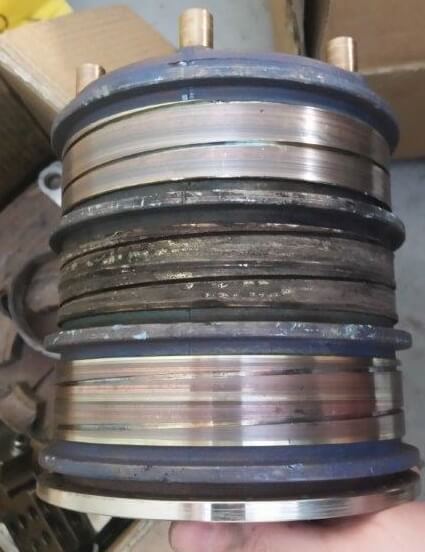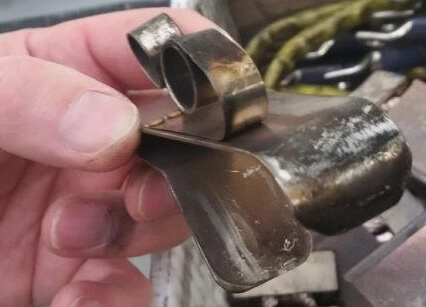Written by: Chris Richards
Sales and Marketing Director, BGB

This wind-turbine slip ring suffered irreparable damage because of excessive copper brush wear.
Brushes are a small but integral part of a wind turbine. A brush is an electrical conductor that works with slip rings and brush holders, protecting vital components from parasitic currents and static electricity. Worn or low-quality brushes can wear on a slip ring, causing it to degrade prematurely or force early component replacement.
Although copper brushes are widely used in the wind industry, turbine manufacturers and operators are reconsidering the use of silver brushes. Copper has typically been the metal of choice because it is fairly reliable and cost-effective. Keeping maintenance costs down is an important key to maximizing wind-farm return on investments.
However, silver brushes are proving the wiser choice for longevity and lifetime performance. Wind operators who select silver devices may pay more now, but benefit from fewer repairs or brush changes long term.
The importance of brushes
Brushes work with slip rings to conduct power in a wind turbine. A slip ring is a rotary coupling used to transfer electric current from a stationary to a rotating unit. In a turbine, the electrical connection to the rotor is made by connections to the brushes.
Brushes can transfer ac or dc current between the rotating section of a wind turbine and the fixed external power supply or converter. These devices signal through rotating parts and protect other components in the turbine from static electricity and lightning strikes.
Brushes that wear evenly indicate good performance over a given set of operating conditions. For example, pitting marks or heavy streaking are signs of overload or grade mismatch. There is a wide range of brush grades and types for slip rings. Some brushes also provide better protection in different environments, such as low or high-humidity climates.

An example of a brush-holder spring that overheated due to brush failure of a copper compound. The intense heat on the phase has caused the brush top to melt and the spring to then temper.
Typically, silver brushes are used in offshore wind turbines because they offer reliable conductivity, a greater wind-capacity factor, and a wider operating range. This metal is apt to endure turbine idling and coastal applications much better than copper brushes. This is because silver is unable to oxidize in salty conditions, which can lead to arcing and sparking.
What’s more is the patina laydown — the protective lubricant for a brush and slip ring— of a silver brush is much easier than with copper.
Quality over quantity
It is important to understand a turbine’s operating temperature and environment when selecting the ideal brush. It is also important to evaluate component quality. While it is ideal to match brushes with the slip rings in use for optimal performance, lower quality components may increase maintenance intervals over time — or cause unexpected turbine downtime.
So, choose these devices wisely. While copper-grade brushes are common and less costly, wind operators are advised to weigh the long-term pros and cons. Reliable, durable performance and efficiency may cost less over time.
Here are three features to consider when selecting brushes for wind turbines.

BGB, a custom precision slip-ring manufacturer, has found an increase in silver carbon brush use in the wind industry. Silver may be more costly than copper alternatives, but silver brushes typically last two to three years longer.
- Life expectancy. A brush is a consumable item, which means it will eventually wear and require replacement. Copper carbon brushes typically have an average life expectancy of one to two years. On the other hand, silver brushes are averaging three to five years.
- Wear rate. Reliability is critical in wind applications that must withstand harsh conditions. Recent test data shows that copper brushes wear by an average of 29mm per year compared to just 16mm for silver devices. What’s more is that silver holds up more effectively in extreme climates, which are typical of many wind farms.
- Maintenance. Replacing wind-turbine brushes is a costly task because it means a wind technician must go onsite and climb up-tower. Copper brushes typically require high levels of regular maintenance from higher carbon dust production. In comparison, silver brushes stay cleaner and offer a reduced oxidation level. Silver also wears in a more distributed fashion, which is better for brush longevity. In fact, one study shows that brush life is about 30% longer on average with silver devices.
Wind-turbine owners and operators practicing predictive maintenance have a good understanding of failure data and how inferior components affect overall performance. These parameters include component life, component or secondary failure costs, downtime and maintenance intervals. These factors add up and should be considered when amortizing the cost of an asset — such as brushes — over a 20-year turbine life.
Filed Under: Components, News, O&M, Seals & slip rings




